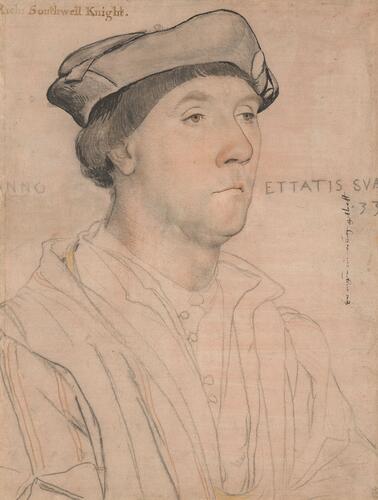-
1 of 253523 objects
Sir Richard Southwell (1502/3-1564) 1536
Black and coloured chalks and black ink on pink prepared paper | 36.6 x 27.7 cm (sheet of paper) | RCIN 912242

Hans Holbein the Younger (1497/8-1543)
Sir Richard Southwell (1502/3-1564) 1536
-
A portrait drawing of Sir Richard Southwell (1502/3-1564). A bust length portrait facing three-quarters to the right, showing the sitter aged 33. This drawing is a preparatory study for painting in the Uffizi, Florence. Inscribed by the artist: Die augen ein wenig gelbatt (the eyes a little yellowish), and in chalk: [A]NNO ETTATIS SVA[E]/.33. Inscribed in an eighteenth-century hand at upper left: Rich: Southwell Knight.
Sir Richard Southwell (1502/3-64) was a Norfolk landowner and Justice of the Peace. As the inscription records, he was drawn by Holbein at the age of 33, the year in which he was appointed Receiver in the Court of Augmentations, and possibly also first became a Member of Parliament. Southwell was careful to ally himself with rising stars and to desert them as they fell. He failed to speak up in defence of Sir Thomas More, despite knowing that evidence against the ex-Chancellor was falsified, and his testimony was responsible for the downfall of Henry Howard, Earl of Surrey, who was executed for treason in January 1547. Thanks to his deft politicking, Southwell largely retained his influence through the reigns of Edward VI and Mary I, on whose behalf he guarded the palace of Whitehall during Thomas Wyatt’s rebellion. It may have been his support for Mary which led to his retirement when her half-sister Elizabeth took the throne.
Holbein’s drawing is a study for a painted portrait of Southwell now in the Uffizi in Florence. Holbein has carefully depicted Southwell’s features, down to the scars on his neck and forehead, which are so convincingly delineated that at first they appear to be imperfections in the paper rather than the sitter’s complexion. In preparation for the portrait, Holbein noted to himself on the side of the sheet that Southwell’s eyes were ‘a little yellowish’, and recorded the Latin inscription that would flank the sitter in the final work.
Southwell was a controversial figure, and Holbein’s portrait has been taken, perhaps unfairly, as evidence of a ‘haughty and indecisive’ character. Whatever Southwell’s attributes, the drawn and painted portraits remain one of the most impressive of Holbein’s careful records of the appearance of members of Henry VIII’s court.
Catalogue entry adapted from The Northern Renaissance. Dürer to Holbein, London 2011Provenance
Henry VIII; Edward VI, 1547; Henry FitzAlan, 12th Earl of Arundel; by whom bequeathed to John, Lord Lumley, 1580; by whom probably bequeathed to Henry, Prince of Wales, 1609, and thus inherited by Prince Charles (later Charles I), 1612; by whom exchanged with Philip Herbert, 4th Earl of Pembroke, 1627/8; by whom given to Thomas Howard, 14th Earl of Arundel; acquired by Charles II by 1675
-
Creator(s)
Acquirer(s)
-
Medium and techniques
Black and coloured chalks and black ink on pink prepared paper
Measurements
36.6 x 27.7 cm (sheet of paper)
Markings
watermark: Close to Briquet 1457, double headed eagle and crown [same as 12214,12256,12221,12260]
Object type(s)
Other number(s)
RL 12242